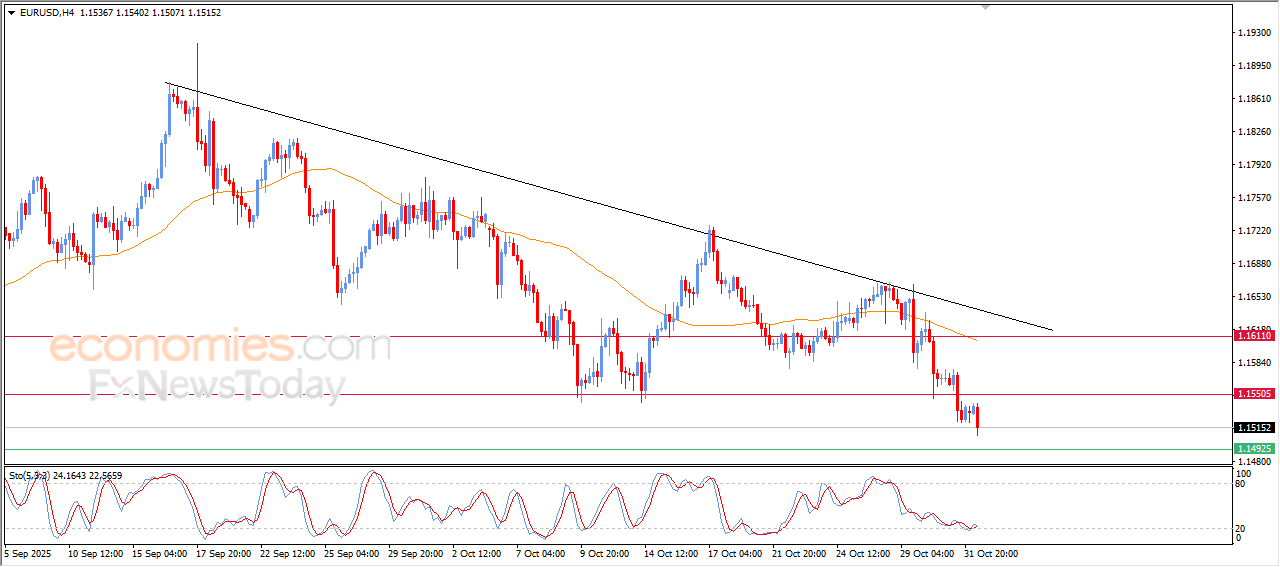Category: Forex News, News
Will the BoE rescue the Pound Sterling?
The Pound Sterling (GBP) accelerated its recent declines against the US Dollar (USD), as GBP/USD briefly revisited levels under the 1.3150 psychological mark.
Pound Sterling suffered amid UK budget woes, USD rebound
Market sentiment was largely driven by hopes of a US-China trade deal and the anticipation of dovish US Federal Reserve (Fed) monetary policy announcements at the start of the week, fuelling fresh declines in the USD.
The odds of a US-China trade deal ramped up after a preliminary consensus on topics including export controls, fentanyl and shipping levies was reached by both sides during their two-day talks in Malaysia.
On October 24, the Bureau of Labor Statistics (BLS) showed that the US Consumer Price Index (CPI) rose 0.3% in September, which drove the annual inflation rate from 2.9% to 3%, the highest it has been since January. The annual CPI inflation came in softer than the market forecast of 3.1%.
Following the softer-than-expected US inflation data, markets almost fully priced in two interest rate reductions this year, with a 25 basis points (bps) cut each in the October and December monetary policy meetings.
This Greenback weakness helped GBP/USD buyers gather some courage to briefly regain the 1.3350 barrier.
However, the pair quickly reversed course and resumed its downtrend after the US Dollar staged a solid comeback against its six major currency rivals on Wednesday, even as the Fed delivered on the expected 25 bps cut.
The rebound occurred because, during the post-policy meeting press conference, Fed Chairman Powell noted that policymakers are likely to become more cautious if the current government shutdown deprives them of further job and inflation reports, tempering bets for another rate cut by the Fed at year-end.
Following the Fed event, the CME Group’s FedWatch Tool showed a 72.8% probability of a quarter percentage point Fed rate cut in December compared with a 91.1% chance a week earlier.
Investors remained nervous heading into Thursday’s highly anticipated meeting between US President Donald Trump and his Chinese counterpart Xi Jinping in South Korea, exerting additional downside pressure on the higher-yielding Pound Sterling.
On Thursday, both leaders reached a major trade truce on the sidelines of the APEC Summit in Busan, South Korea. The landmark agreement covers key critical points, including rare earth minerals, fentanyl trade, and semiconductor sales.
Trump said that “tariffs on China will be 47% down from 57%.” Meanwhile, China’s Commerce Ministry confirmed that Beijing will pause rare earth export controls for a year, adding that “both sides reached consensus on fentanyl cooperation, expanding agriculture trade.”
The US-China trade deal optimism provided extra legs to the USD upswing, in the aftermath of a less dovish Fed, exacerbating GBP/USD’s pain. The currency pair breached critical support levels to reach six-month lows near 1.3115.
On the UK side of the equation, the Pound Sterling faced additional headwinds as investors grew increasingly anxious ahead of Chancellor Rachel Reeves’s Autumn Budget, due on November 26.
Reuters reported that the Office for Budget Responsibility (OBR) is expected to lower productivity forecasts, raising financial stress and boding ill for the British Pound.
The GBP was also undermined by the markets’ beliefs that mounting concerns over UK economic growth prospects could persuade the Bank of England (BoE) to resume its easing cycle in December after a rates-on-hold decision expected on Thursday.
US ADP jobs data, US ISM PMIs and BoE verdict grab eyeballs
With the Fed event and the Trump-Xi meeting finally out of the way, traders now focus on the BoE policy announcements and the private sector employment and economic activity data from the United States (US). While official data is very unlikely to be published due to the shutdown, some private-sector indicators are expected to provide insights into the state of the US economy and the labor market.
On October 30, the US Senate adjourned and won’t meet again until Monday, extending the government shutdown until at least its 34th day, which would almost make it the longest funding lapse in American history.
This leaves traders again in a data drought situation on the US calendar. In case the government reopens, a bunch of delayed top-tier statistics will be published. In this scenario, the spotlight would be on the September Nonfarm Payrolls (NFP) data.
Tuesday will see the release of the US ISM Manufacturing PMI data, while the JOLTS Job Openings survey is unlikely to be published unless the US government reopens.
On Wednesday, the monthly private employment data from the Automatic Data Processing (ADP) will be closely scrutinized to gauge the health of the US labor market. ADP’s employment report showed private payrolls decreased by 32,000 jobs in September.
Meanwhile, the ADP published its National Employment Report’s inaugural weekly preliminary estimate on Tuesday, showing that US private payrolls increased by an average 14,250 jobs in the four weeks ending October 11.
The US ISM Services PMI will also feature on Wednesday.
That being said, the BoE ‘Super Thursday’ will help determine the next trend in GBP/USD. The BoE is widely expected to hold the key policy rate at 4%, but the updated projections and Governor Andrew Bailey’s hints on future rate cuts will likely boost volatility around the Pound Sterling.
Apart from the economic news, trade and geopolitical headlines will be monitored in the upcoming week. Speeches from Fed policymakers will also affect the USD-driven GBP/USD price action.
GBP/USD: Technical outlook
On the daily chart, GBP/USD is currently trading at around 1.3155, with spot entrenched below all major moving averages and the near-term structure skewed lower. A bearish 21-day Simple Moving Average (SMA) slides below the longer 50 and 100 SMAs, collectively signaling sellers hold the grip and hinting at additional slides ahead. Despite the 200-day SMA edging higher, it remains above price and caps the topside, leaving the broader bias negative as falling short- and medium-term averages stack overhead.
Momentum gauges echo the downbeat tone, with the Relative Strength Index (RSI) (14) hovering near 30.4 after a dip to 29.9, indicating persistent bearish pressure with only tentative stabilization. Resistance levels align at 1.3248 (200-day SMA), 1.3345 (21-day SMA), 1.3434 (50-day SMA) and 1.3464 (100-day SMA). A sustained break above 1.3248 would be needed to ease selling pressure and open the path toward the 21-day/50-day SMAs, while failure to reclaim the 200-day line keeps risks tilted to the downside.
Looking down, GBP/USD meets initial support at the 1.3140 area (May 12, August 1, Wednesday’s lows), followed by 1.3116, the lowest level since mid-April, hit on Thursday. With no indicator-derived supports below current levels, bears retain the upper hand until momentum meaningfully improves.
(The technical analysis of this story was written with the help of an AI tool.)
Pound Sterling FAQs
The Pound Sterling (GBP) is the oldest currency in the world (886 AD) and the official currency of the United Kingdom. It is the fourth most traded unit for foreign exchange (FX) in the world, accounting for 12% of all transactions, averaging $630 billion a day, according to 2022 data.
Its key trading pairs are GBP/USD, also known as ‘Cable’, which accounts for 11% of FX, GBP/JPY, or the ‘Dragon’ as it is known by traders (3%), and EUR/GBP (2%). The Pound Sterling is issued by the Bank of England (BoE).
The single most important factor influencing the value of the Pound Sterling is monetary policy decided by the Bank of England. The BoE bases its decisions on whether it has achieved its primary goal of “price stability” – a steady inflation rate of around 2%. Its primary tool for achieving this is the adjustment of interest rates.
When inflation is too high, the BoE will try to rein it in by raising interest rates, making it more expensive for people and businesses to access credit. This is generally positive for GBP, as higher interest rates make the UK a more attractive place for global investors to park their money.
When inflation falls too low it is a sign economic growth is slowing. In this scenario, the BoE will consider lowering interest rates to cheapen credit so businesses will borrow more to invest in growth-generating projects.
Data releases gauge the health of the economy and can impact the value of the Pound Sterling. Indicators such as GDP, Manufacturing and Services PMIs, and employment can all influence the direction of the GBP.
A strong economy is good for Sterling. Not only does it attract more foreign investment but it may encourage the BoE to put up interest rates, which will directly strengthen GBP. Otherwise, if economic data is weak, the Pound Sterling is likely to fall.
Another significant data release for the Pound Sterling is the Trade Balance. This indicator measures the difference between what a country earns from its exports and what it spends on imports over a given period.
If a country produces highly sought-after exports, its currency will benefit purely from the extra demand created from foreign buyers seeking to purchase these goods. Therefore, a positive net Trade Balance strengthens a currency and vice versa for a negative balance.
Written by : Editorial team of BIPNs
Main team of content of bipns.com. Any type of content should be approved by us.
Share this article:









